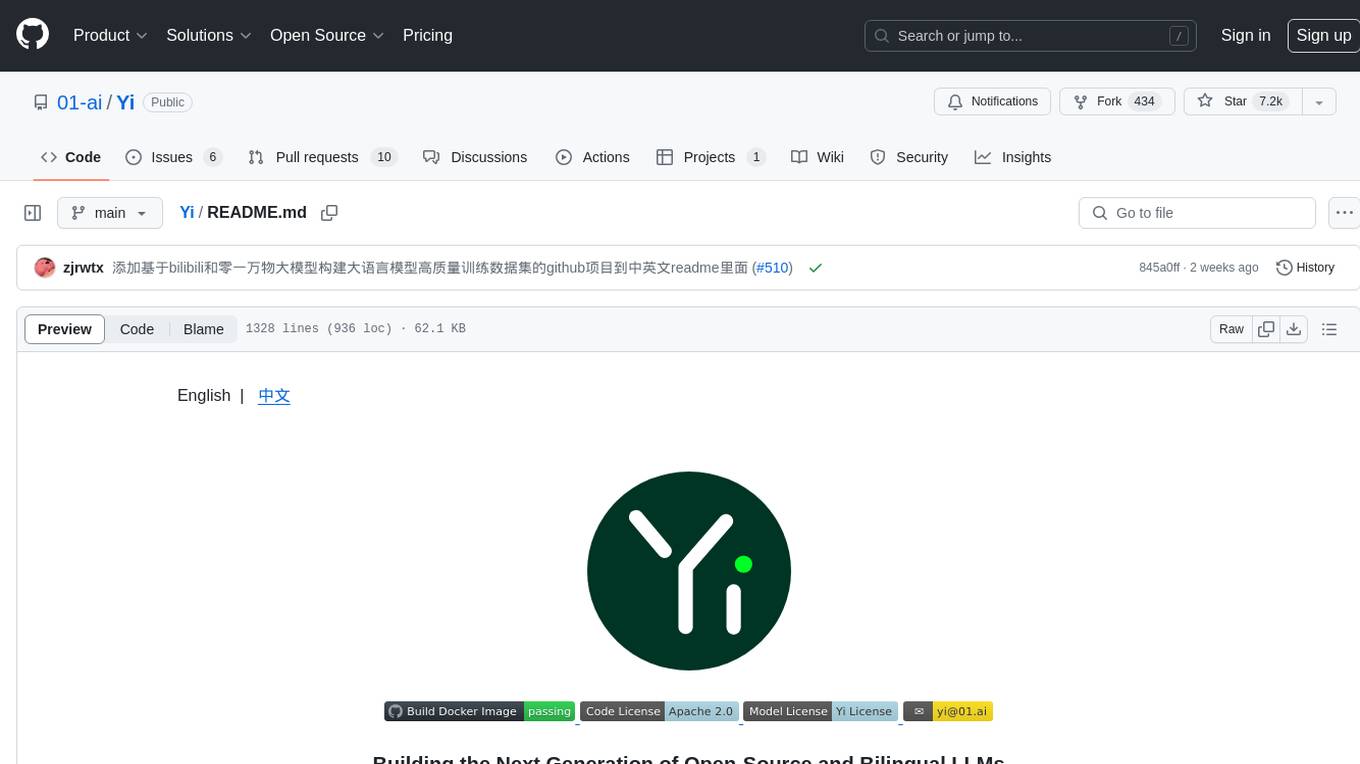
LLM-Finetune-Guide
Arrange methods and example on finetune LLMs
Stars: 60
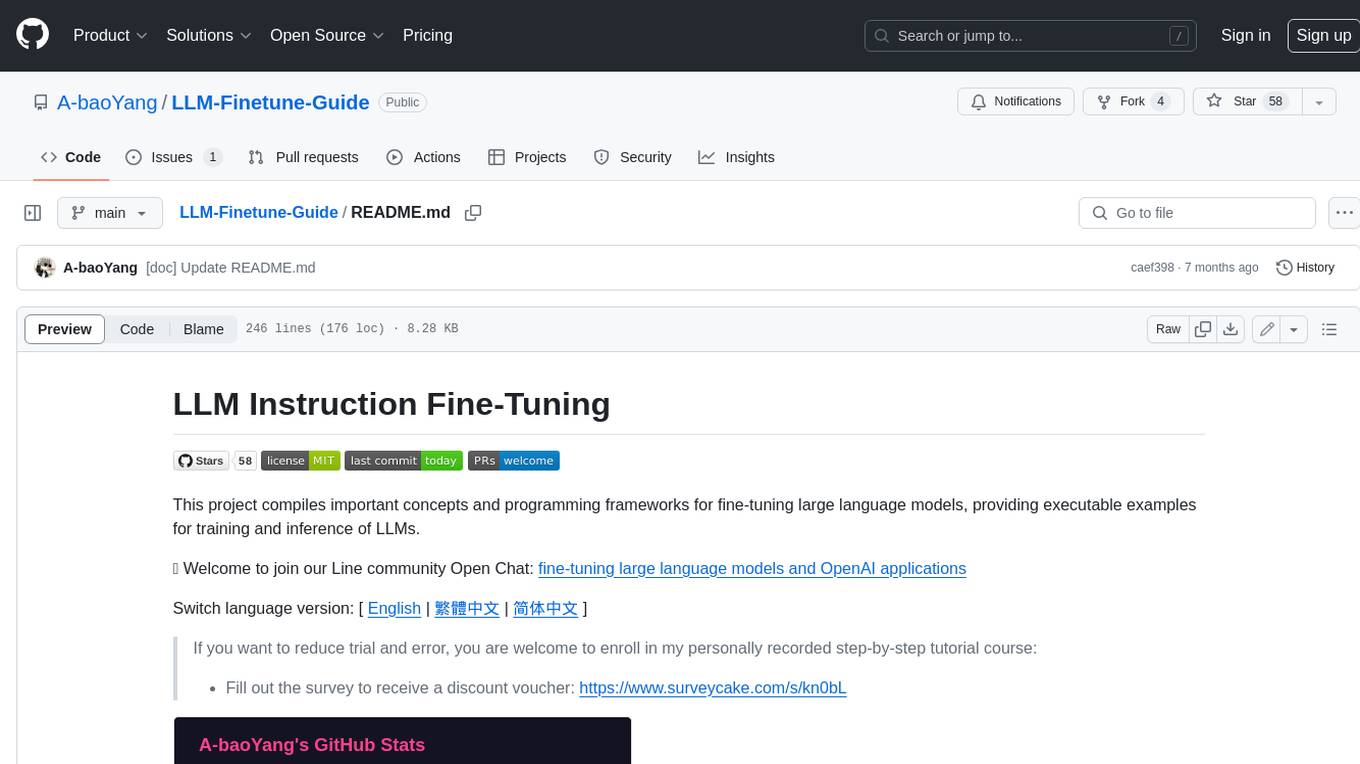
This project provides a comprehensive guide to fine-tuning large language models (LLMs) with efficient methods like LoRA and P-tuning V2. It includes detailed instructions, code examples, and performance benchmarks for various LLMs and fine-tuning techniques. The guide also covers data preparation, evaluation, prediction, and running inference on CPU environments. By leveraging this guide, users can effectively fine-tune LLMs for specific tasks and applications.
README:
This project compiles important concepts and programming frameworks for fine-tuning large language models, providing executable examples for training and inference of LLMs.
👋 Welcome to join our Line community Open Chat: fine-tuning large language models and OpenAI applications
Switch language version: [ English | 繁體中文 | 简体中文 ]
If you want to reduce trial and error, you are welcome to enroll in my personally recorded step-by-step tutorial course:
- Fill out the survey to receive a discount voucher: https://www.surveycake.com/s/kn0bL
Currently, the following efficient fine-tuning methods are supported:
- LoRA
- P-tuning V2
Training Arguments:
| LLM | Fine-Tuning Method | Quantization Methods | Distributed Training Strategy | Batch Size | Required GPU memory (per card) | Speed |
|---|---|---|---|---|---|---|
| Bloom | LoRA | INT8 | None | 1 | 14GB | 86.71s/it |
| Bloom | LoRA | INT8 | Torch DDP on 2 GPUs | 1 | 13GB | 44.47s/it |
| Bloom | LoRA | INT8 | DeepSpeed ZeRO stage 3 on 2 GPUs | 1 | 13GB | 36.05s/it |
| ChatGLM-6B | P-Tuning | INT4 | DeepSpeed ZeRO stage 3 on 2 GPUs | 2 | 15GB | 14.7s/it |
You can choose to fine-tune with open-source or academic datasets, but if the open-source datasets do not fit your application scenario, you will need to use custom datasets for fine-tuning.
In this project, the format used for the dataset is .json. You will need to put the train, dev, and test files of the separated dataset in the instruction-datasets/ directory. You can also create a new folder to place the files, but the path should be specified accordingly in the commands.
Different fine-tuning methods have their required packages set up. To install them, simply navigate to the folder with requirements.txt and run:
git clone https://github.com/A-baoYang/LLM-FineTuning-Guide.git
conda create -n llm_ift python=3.8
conda activate llm_ift
cd LLM-Finetune-Guide/efficient-finetune/ptuning/v2
pip install -r requirements.txtAfter the data is prepared, you can start fine-tuning. The program has already been written and you can specify the data/model path and parameter replacement through the command.
CUDA_VISIBLE_DEVICES=0 python finetune.py \
--do_train \
--train_file ../../../instruction-datasets/$DATATAG/train.json \
--validation_file ../../../instruction-datasets/$DATATAG/dev.json \
--prompt_column input \
--response_column output \
--overwrite_cache \
--model_name_or_path $MODEL_PATH \
--output_dir finetuned/$DATATAG-$MODEL_TYPE-pt-$PRE_SEQ_LEN-$LRPlease refer to the complete parameter and command settings at: finetune.sh
- Start with
torchrun
torchrun --standalone --nnodes=1 --nproc_per_node=2 finetune.py --do_train \
--train_file ../../../instruction-datasets/$DATATAG/train.json \
--validation_file ../../../instruction-datasets/$DATATAG/dev.json \
--prompt_column input \
--response_column output \
--overwrite_cache \
--model_name_or_path $MODEL_PATH \
--output_dir finetuned/$DATATAG-$MODEL_TYPE-pt-$PRE_SEQ_LEN-$LR \Please refer to the complete parameter and command settings at: finetune-ddp.sh
- Start with
accelerate
accelerate launch finetune.py --do_train \
--train_file ../../../instruction-datasets/$DATATAG/train.json \
--validation_file ../../../instruction-datasets/$DATATAG/dev.json \
--prompt_column input \
--response_column output \
--overwrite_cache \
--model_name_or_path $MODEL_PATH \
--output_dir finetuned/$DATATAG-$MODEL_TYPE-pt-$PRE_SEQ_LEN-$LR \- Start with
accelerateandconfig_filearguments
accelerate launch --config_file ../../config/use_deepspeed.yaml finetune.py --do_train \
--train_file ../../../instruction-datasets/$DATATAG/train.json \
--validation_file ../../../instruction-datasets/$DATATAG/dev.json \
--prompt_column input \
--response_column output \
--overwrite_cache \
--model_name_or_path $MODEL_PATH \
--output_dir finetuned/$DATATAG-$MODEL_TYPE-pt-$PRE_SEQ_LEN-$LR \- Start with
deepspeed
deepspeed --num_nodes 1 --num_gpus 2 finetune.py \
--deepspeed ../../config/zero_stage3_offload_config.json \
--do_train \
--train_file ../../../instruction-datasets/$DATATAG/train.json \
--validation_file ../../../instruction-datasets/$DATATAG/dev.json \
--prompt_column input \
--response_column output \
--overwrite_cache \
--model_name_or_path $MODEL_PATH \
--output_dir finetuned/$DATATAG-$MODEL_TYPE-pt-$PRE_SEQ_LEN-$LR \- For more fine-tuning examples, see: efficient-finetune/README.md
CUDA_VISIBLE_DEVICES=0 python finetune.py \
--do_predict \
--validation_file ../../../instruction-datasets/$DATATAG/dev.json \
--test_file ../../../instruction-datasets/$DATATAG/test.json \
--overwrite_cache \
--prompt_column input \
--response_column output \
--model_name_or_path $MODEL_PATH \
--ptuning_checkpoint finetuned/$DATATAG-$MODEL_TYPE-pt-$PRE_SEQ_LEN-$LR/checkpoint-$STEP \
--output_dir finetuned/$DATATAG-$MODEL_TYPE-pt-$PRE_SEQ_LEN-$LR- Terminal
cd LLM-Finetune-Guide/efficient-finetune/ptuning/v2/serve/
CUDA_VISIBLE_DEVICES=0 python cli_demo.py \
--pretrained_model_path THUDM/chatglm-6b \
--ptuning_checkpoint ../finetuned/chatglm-6b-pt-512-2e-2/checkpoint-3000 \
--is_cuda True- Web demo
cd LLM-Finetune-Guide/efficient-finetune/lora/serve/
python ui.py- Model API
cd LLM-Finetune-Guide/efficient-finetune/lora/serve/
python api.pyThe ability to run fine-tuned large language models in a CPU environment would greatly reduce the application threshold of LLMs.
- Use INT4 to run in CPU environment
cd LLM-Finetune-Guide/efficient-finetune/ptuning/v2/serve/
CUDA_VISIBLE_DEVICES=0 python cli_demo.py \
--pretrained_model_path THUDM/chatglm-6b \
--ptuning_checkpoint ../finetuned/chatglm-6b-pt-512-2e-2/checkpoint-3000 \
--quantization_bit 4 \
--is_cuda True- Repository License: Apache-2.0 License
- Model License: Please refer to the license provided by each language model for details.
If this project is helpful to your work or research, please star & cite it as follows:
@Misc{LLM-Finetune-Guide,
title = {LLM Finetune Guide},
author = {A-baoYang},
howpublished = {\url{https://github.com/A-baoYang/LLM-Finetune-Guide}},
year = {2023}
}
This project was inspired by some amazing projects, which are listed below. Thanks for their great work.
- [THUDM/ChatGLM-6B]
- [ymcui/Chinese-LLaMA-Alpaca]
- [tloen/alpaca-lora]
If you have any questions or suggestions, please feel free to email us for inquiries: [email protected]
For Tasks:
Click tags to check more tools for each tasksFor Jobs:
Alternative AI tools for LLM-Finetune-Guide
Similar Open Source Tools

LLM-Finetune-Guide
This project provides a comprehensive guide to fine-tuning large language models (LLMs) with efficient methods like LoRA and P-tuning V2. It includes detailed instructions, code examples, and performance benchmarks for various LLMs and fine-tuning techniques. The guide also covers data preparation, evaluation, prediction, and running inference on CPU environments. By leveraging this guide, users can effectively fine-tune LLMs for specific tasks and applications.
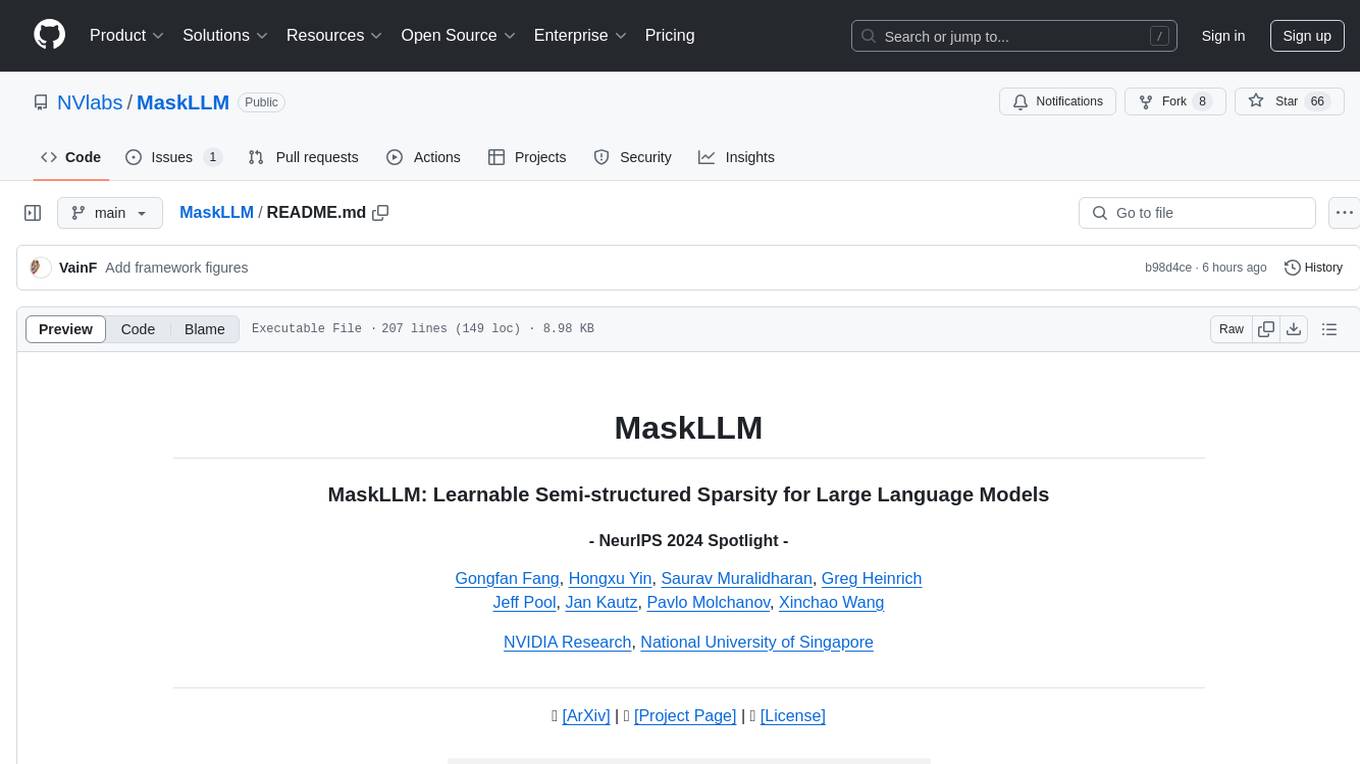
MaskLLM
MaskLLM is a learnable pruning method that establishes Semi-structured Sparsity in Large Language Models (LLMs) to reduce computational overhead during inference. It is scalable and benefits from larger training datasets. The tool provides examples for running MaskLLM with Megatron-LM, preparing LLaMA checkpoints, pre-tokenizing C4 data for Megatron, generating prior masks, training MaskLLM, and evaluating the model. It also includes instructions for exporting sparse models to Huggingface.
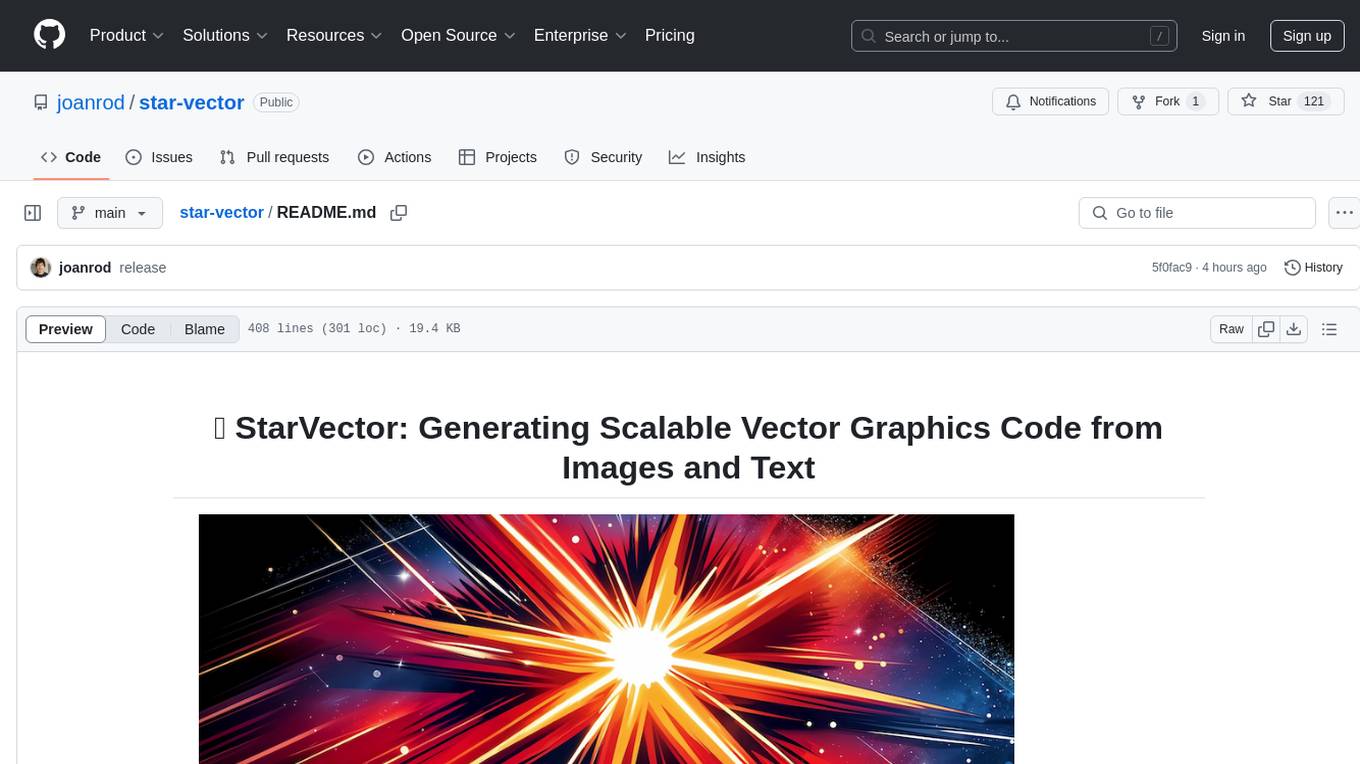
star-vector
StarVector is a multimodal vision-language model for Scalable Vector Graphics (SVG) generation. It can be used to perform image2SVG and text2SVG generation. StarVector works directly in the SVG code space, leveraging visual understanding to apply accurate SVG primitives. It achieves state-of-the-art performance in producing compact and semantically rich SVGs. The tool provides Hugging Face model checkpoints for image2SVG vectorization, with models like StarVector-8B and StarVector-1B. It also offers datasets like SVG-Stack, SVG-Fonts, SVG-Icons, SVG-Emoji, and SVG-Diagrams for evaluation. StarVector can be trained using Deepspeed or FSDP for tasks like Image2SVG and Text2SVG generation. The tool provides a demo with options for HuggingFace generation or VLLM backend for faster generation speed.
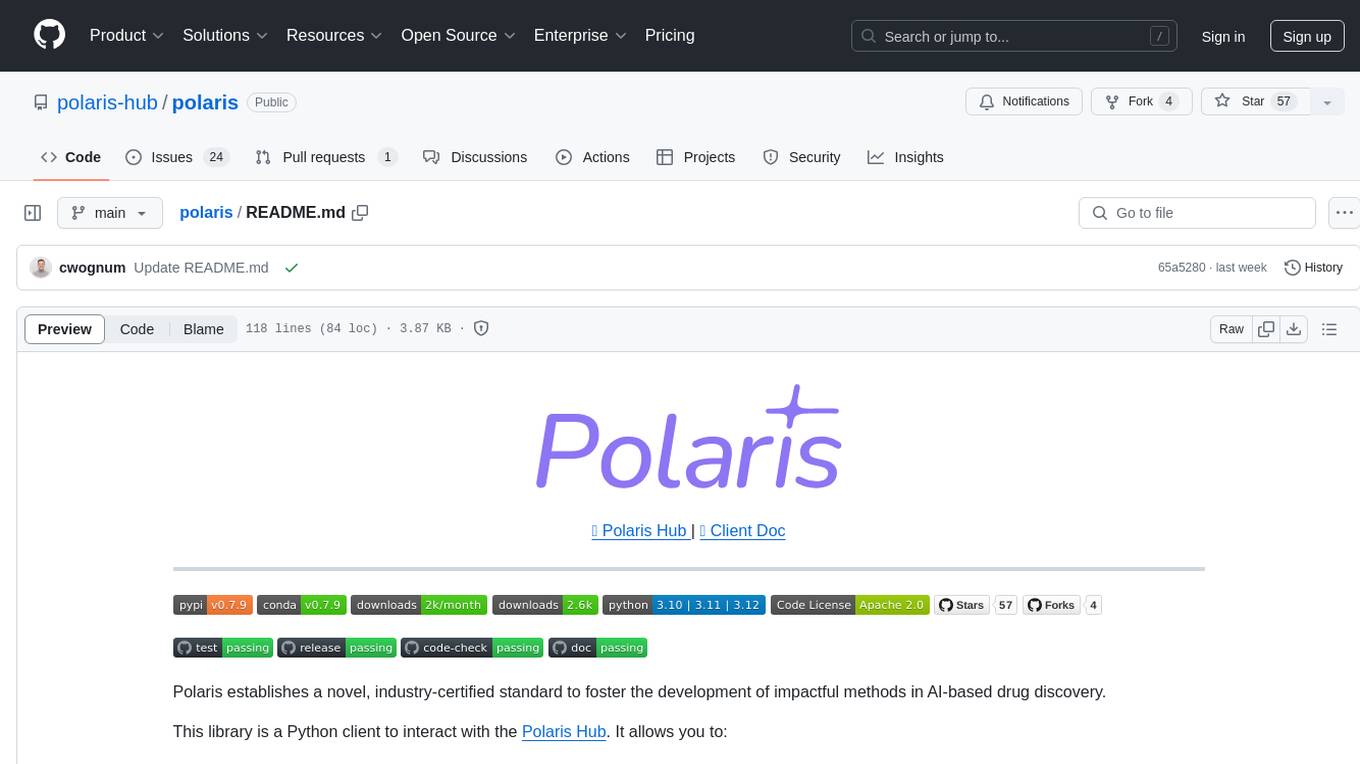
polaris
Polaris establishes a novel, industry‑certified standard to foster the development of impactful methods in AI-based drug discovery. This library is a Python client to interact with the Polaris Hub. It allows you to download Polaris datasets and benchmarks, evaluate a custom method against a Polaris benchmark, and create and upload new datasets and benchmarks.
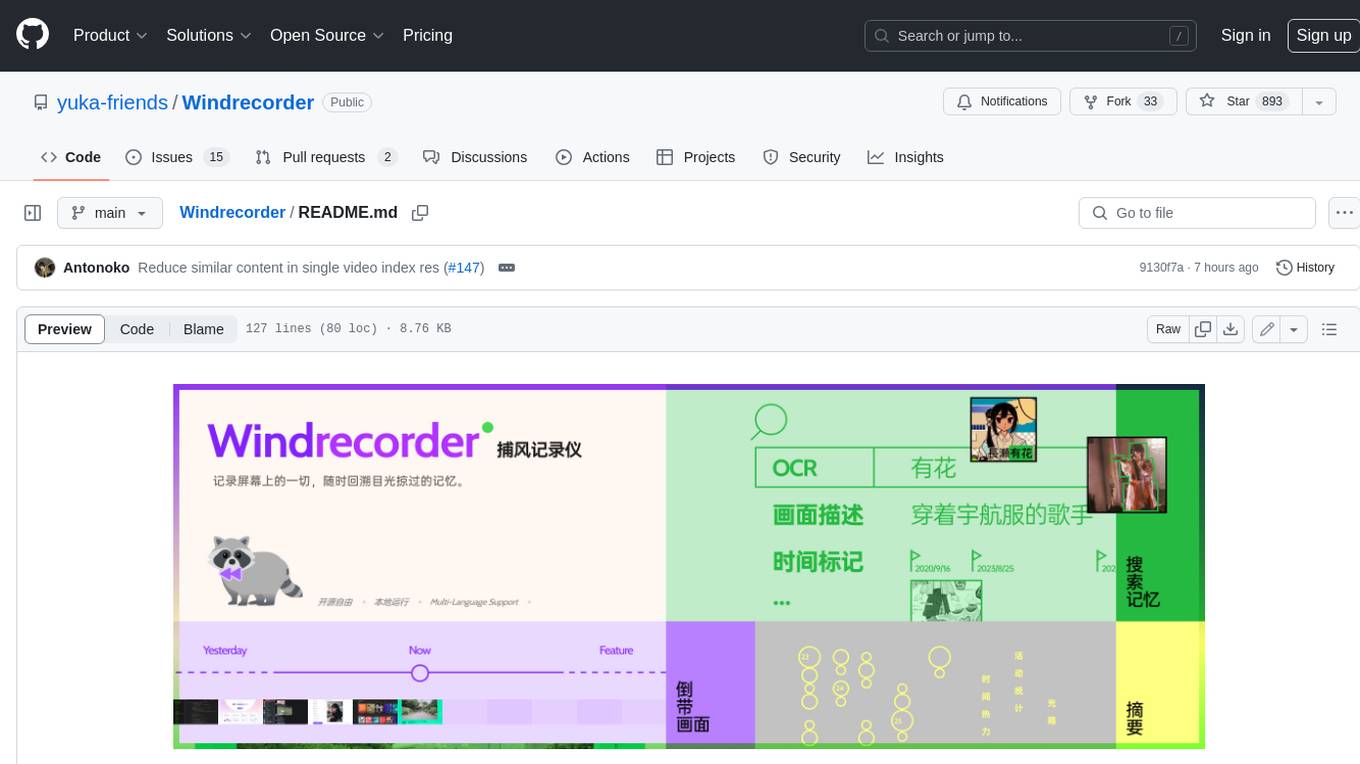
Windrecorder
Windrecorder is an open-source tool that helps you retrieve memory cues by recording everything on your screen. It can search based on OCR text or image descriptions and provides a summary of your activities. All of its capabilities run entirely locally, without the need for an internet connection or uploading any data, giving you complete ownership of your data.
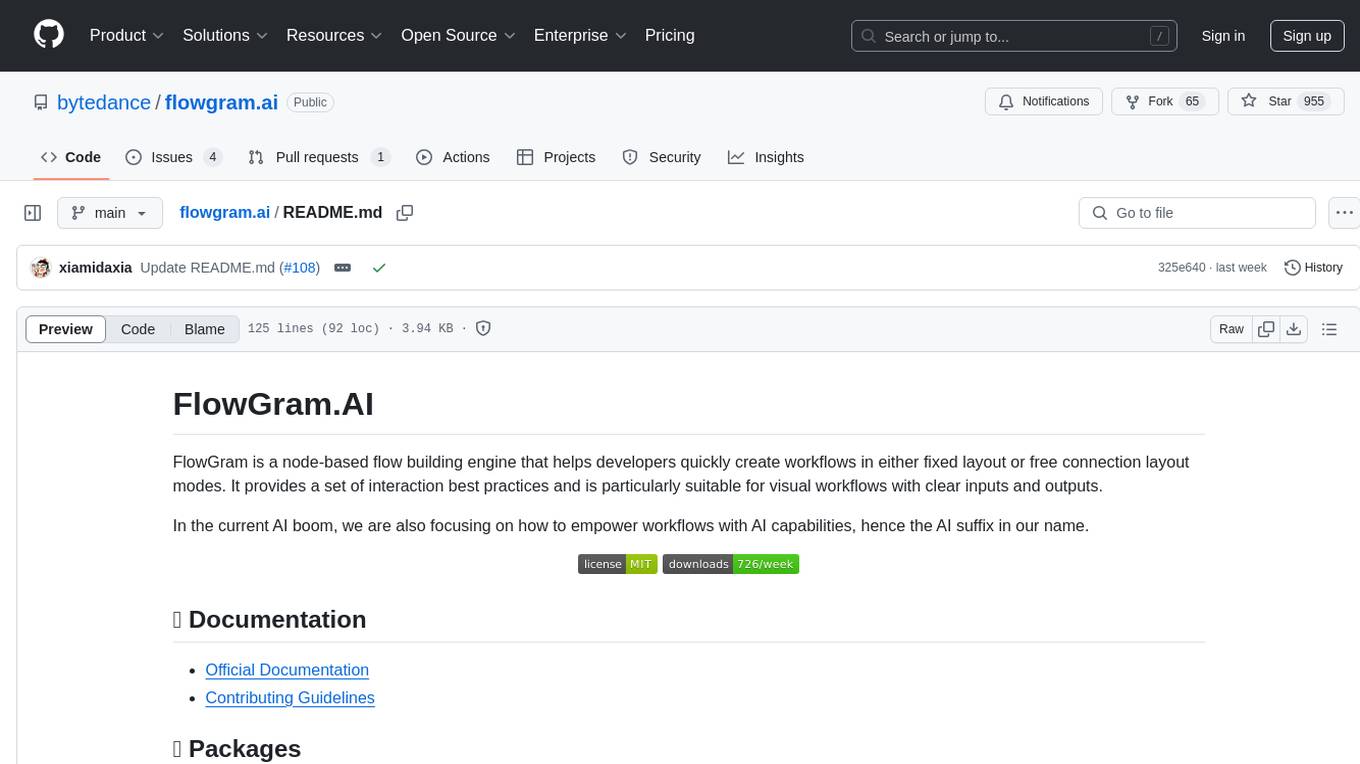
flowgram.ai
FlowGram.AI is a node-based flow building engine that helps developers create workflows in fixed or free connection layout modes. It provides interaction best practices and is suitable for visual workflows with clear inputs and outputs. The tool focuses on empowering workflows with AI capabilities.
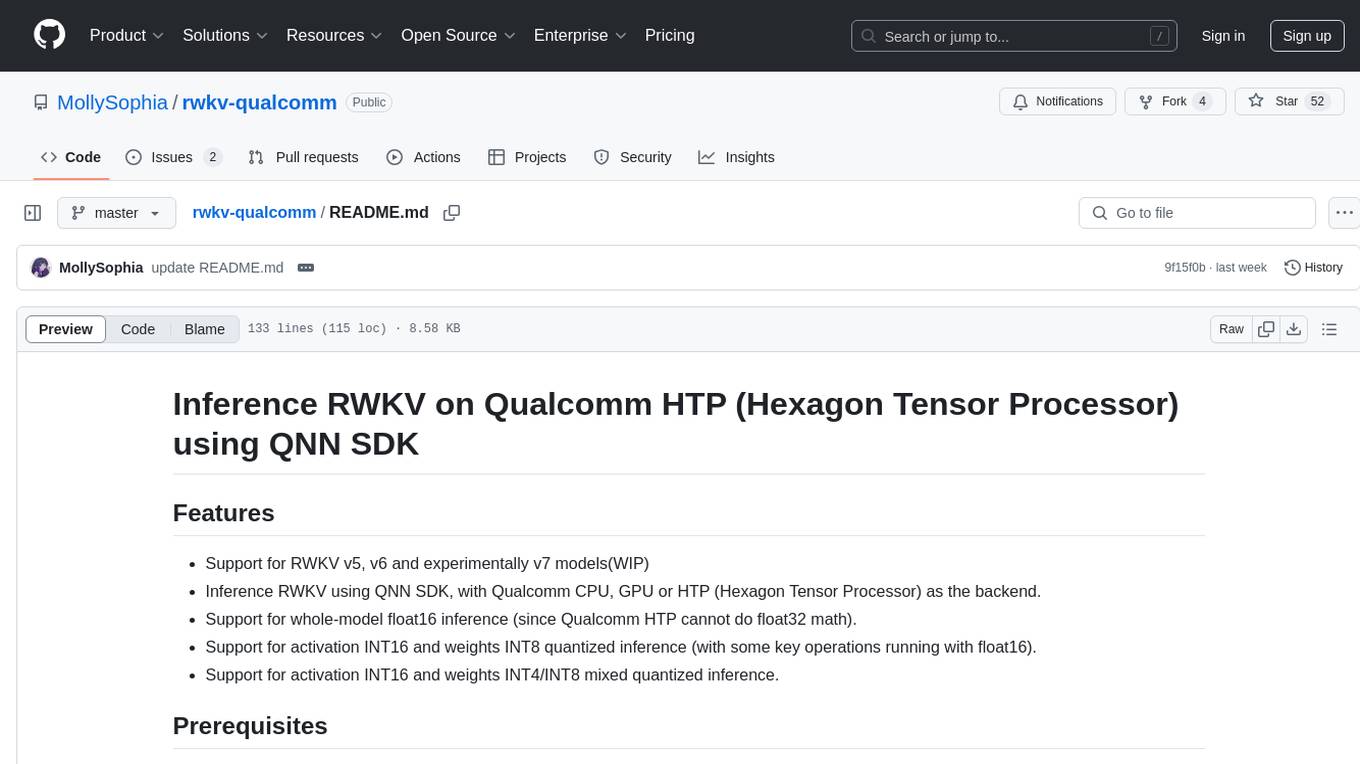
rwkv-qualcomm
This repository provides support for inference RWKV models on Qualcomm HTP (Hexagon Tensor Processor) using QNN SDK. It supports RWKV v5, v6, and experimentally v7 models, inference using Qualcomm CPU, GPU, or HTP as the backend, whole-model float16 inference, activation INT16 and weights INT8 quantized inference, and activation INT16 and weights INT4/INT8 mixed quantized inference. Users can convert model weights to QNN model library files, generate HTP context cache, and run inference on Qualcomm Snapdragon SM8650 with HTP v75. The project requires QNN SDK, AIMET toolkit, and specific hardware for verification.
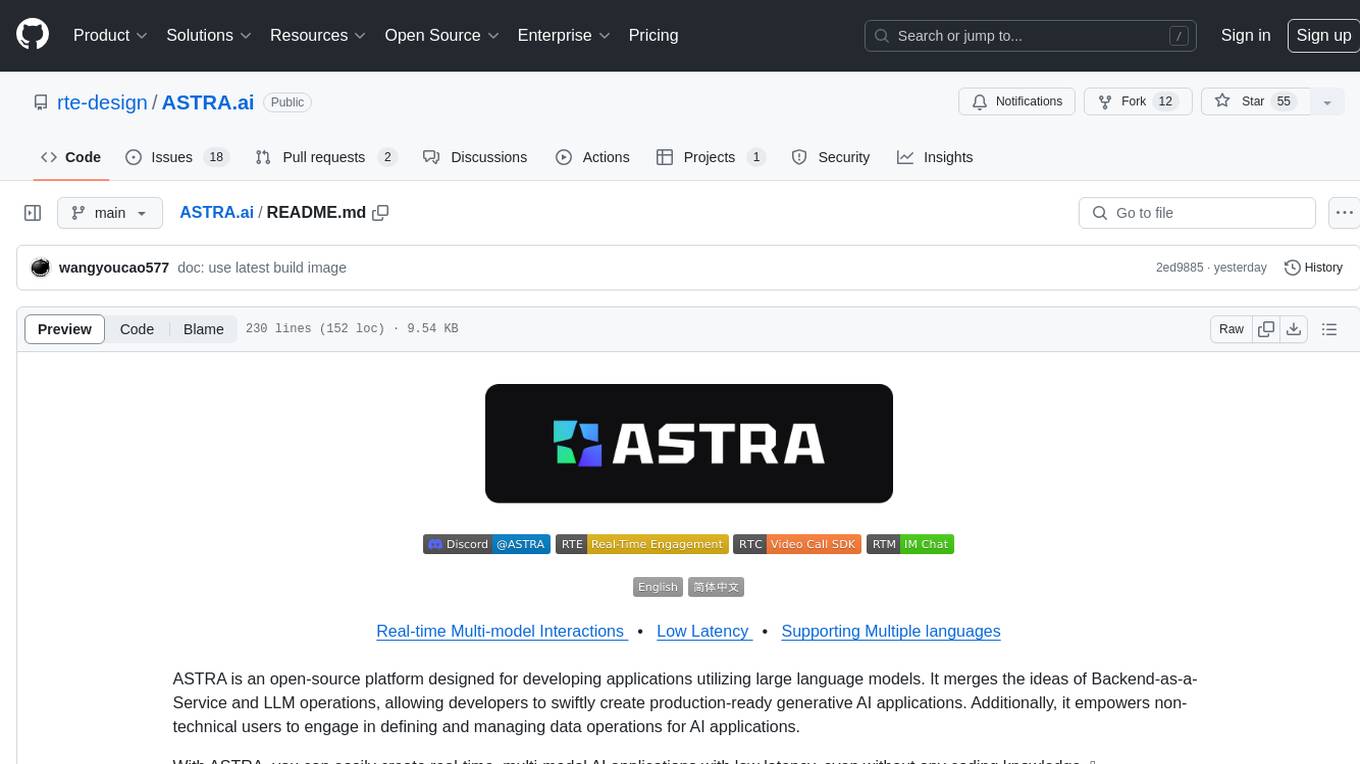
ASTRA.ai
ASTRA is an open-source platform designed for developing applications utilizing large language models. It merges the ideas of Backend-as-a-Service and LLM operations, allowing developers to swiftly create production-ready generative AI applications. Additionally, it empowers non-technical users to engage in defining and managing data operations for AI applications. With ASTRA, you can easily create real-time, multi-modal AI applications with low latency, even without any coding knowledge.

coze-js
Coze-js is a monorepo containing packages for Coze API and Realtime API. It provides usage examples for Node.js and React Web, as well as full console and sample call up demos. The tool requires Node.js 18+, pnpm 9.12.0, and Rush 5.140.0 for installation. Developers can start developing projects within the repository by following the provided steps. Each package in the monorepo can be developed and published independently, with documentation on contributing guidelines and publishing. The tool is licensed under MIT.
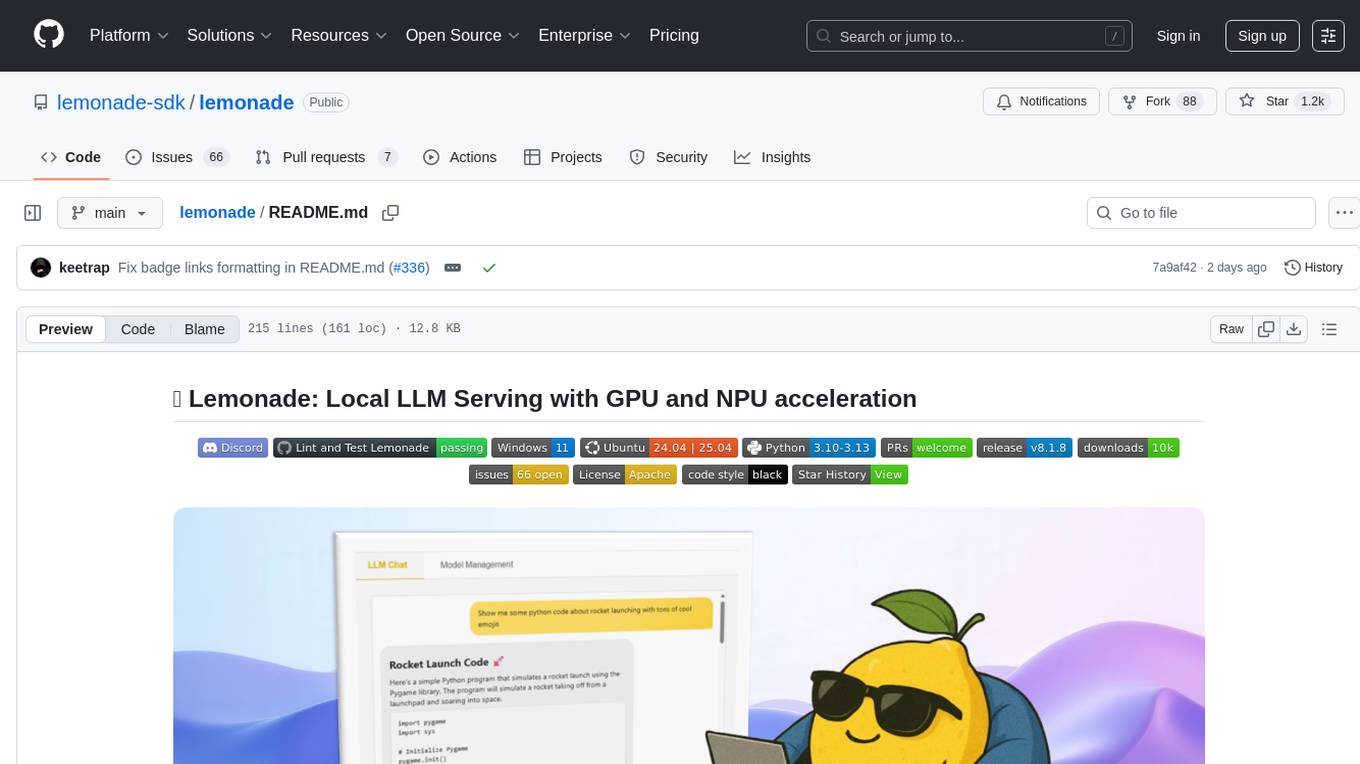
lemonade
Lemonade is a tool that helps users run local Large Language Models (LLMs) with high performance by configuring state-of-the-art inference engines for their Neural Processing Units (NPUs) and Graphics Processing Units (GPUs). It is used by startups, research teams, and large companies to run LLMs efficiently. Lemonade provides a high-level Python API for direct integration of LLMs into Python applications and a CLI for mixing and matching LLMs with various features like prompting templates, accuracy testing, performance benchmarking, and memory profiling. The tool supports both GGUF and ONNX models and allows importing custom models from Hugging Face using the Model Manager. Lemonade is designed to be easy to use and switch between different configurations at runtime, making it a versatile tool for running LLMs locally.
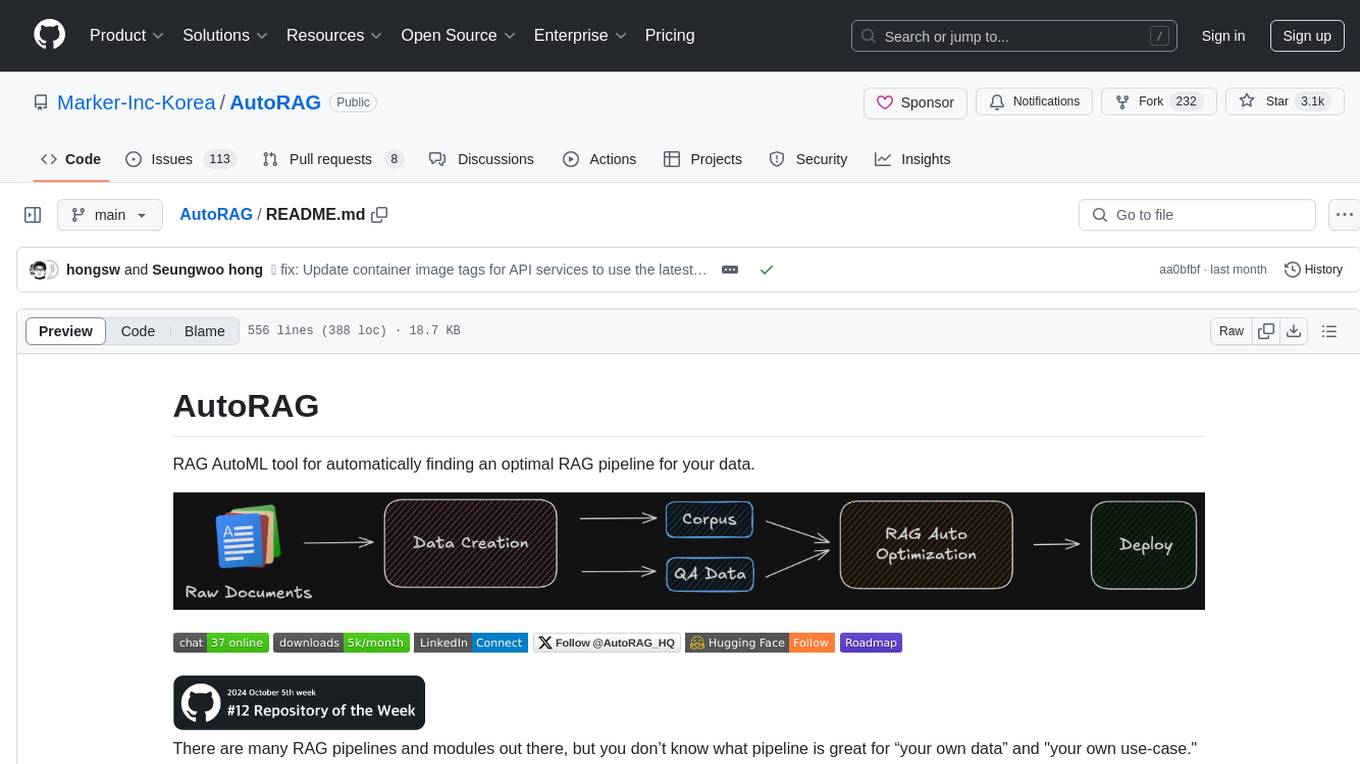
AutoRAG
AutoRAG is an AutoML tool designed to automatically find the optimal RAG pipeline for your data. It simplifies the process of evaluating various RAG modules to identify the best pipeline for your specific use-case. The tool supports easy evaluation of different module combinations, making it efficient to find the most suitable RAG pipeline for your needs. AutoRAG also offers a cloud beta version to assist users in running and optimizing the tool, along with building RAG evaluation datasets for a starting price of $9.99 per optimization.
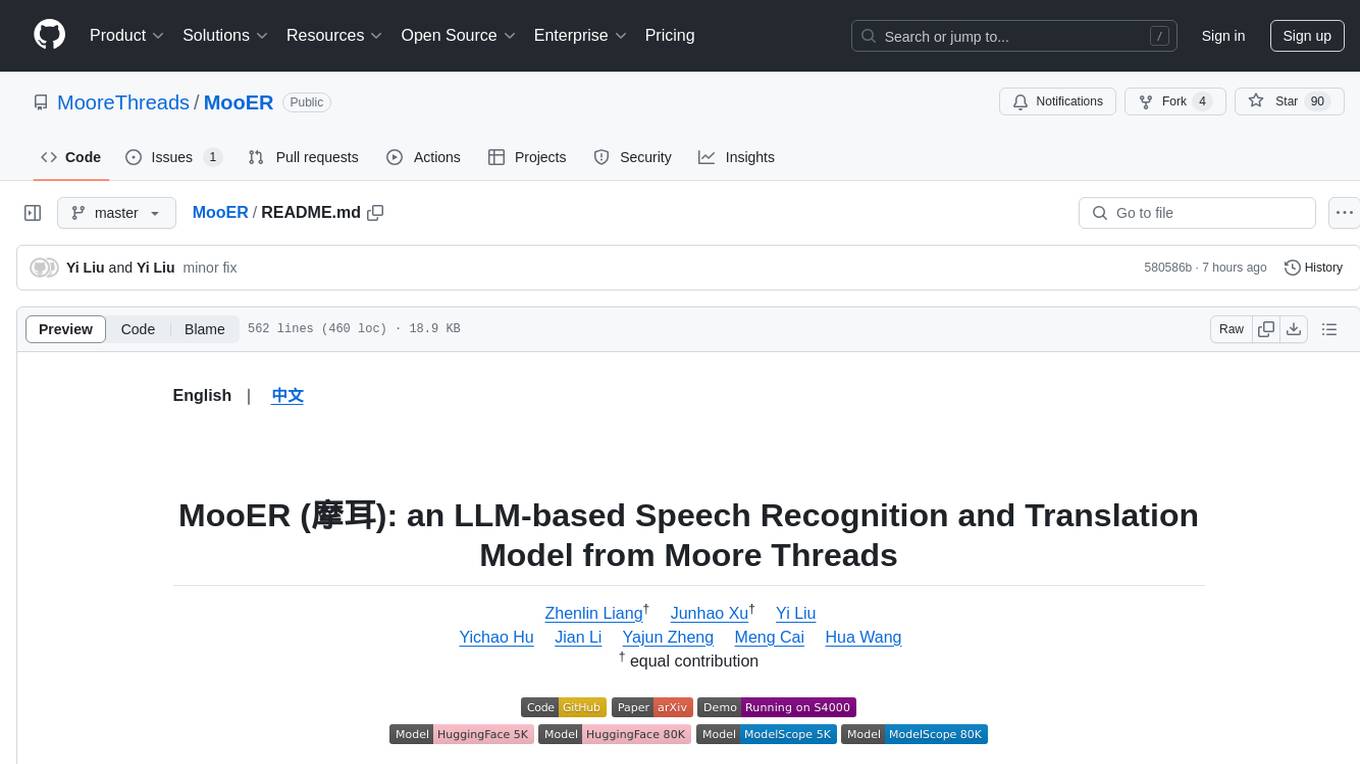
MooER
MooER (摩耳) is an LLM-based speech recognition and translation model developed by Moore Threads. It allows users to transcribe speech into text (ASR) and translate speech into other languages (AST) in an end-to-end manner. The model was trained using 5K hours of data and is now also available with an 80K hours version. MooER is the first LLM-based speech model trained and inferred using domestic GPUs. The repository includes pretrained models, inference code, and a Gradio demo for a better user experience.
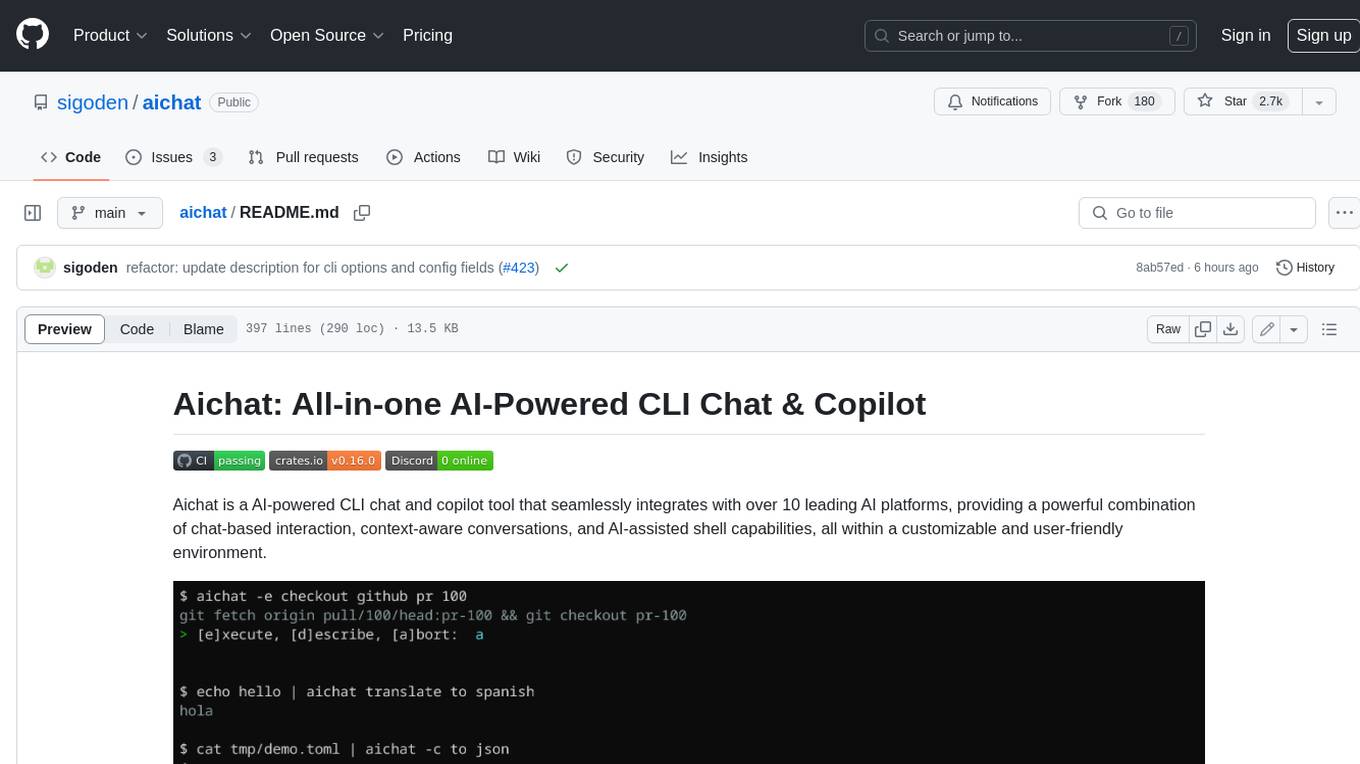
aichat
Aichat is an AI-powered CLI chat and copilot tool that seamlessly integrates with over 10 leading AI platforms, providing a powerful combination of chat-based interaction, context-aware conversations, and AI-assisted shell capabilities, all within a customizable and user-friendly environment.
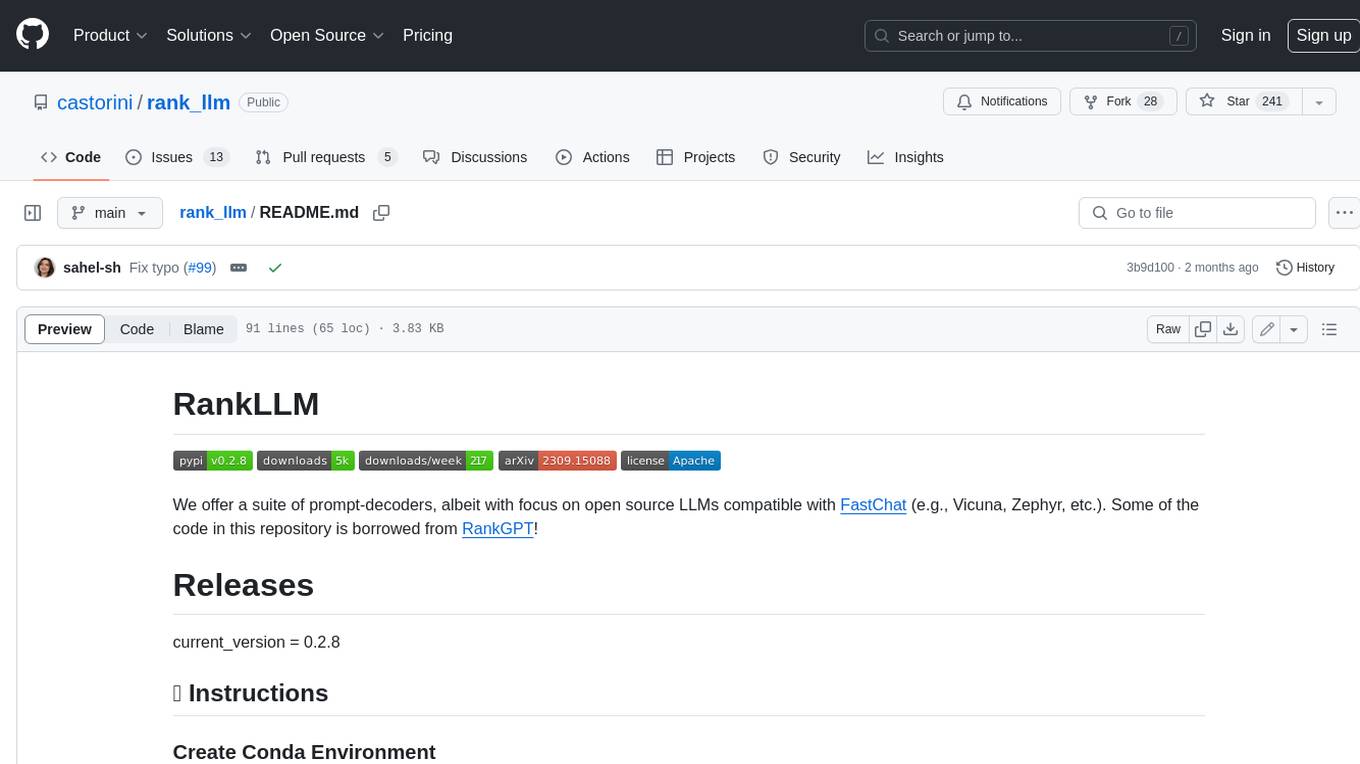
rank_llm
RankLLM is a suite of prompt-decoders compatible with open source LLMs like Vicuna and Zephyr. It allows users to create custom ranking models for various NLP tasks, such as document reranking, question answering, and summarization. The tool offers a variety of features, including the ability to fine-tune models on custom datasets, use different retrieval methods, and control the context size and variable passages. RankLLM is easy to use and can be integrated into existing NLP pipelines.
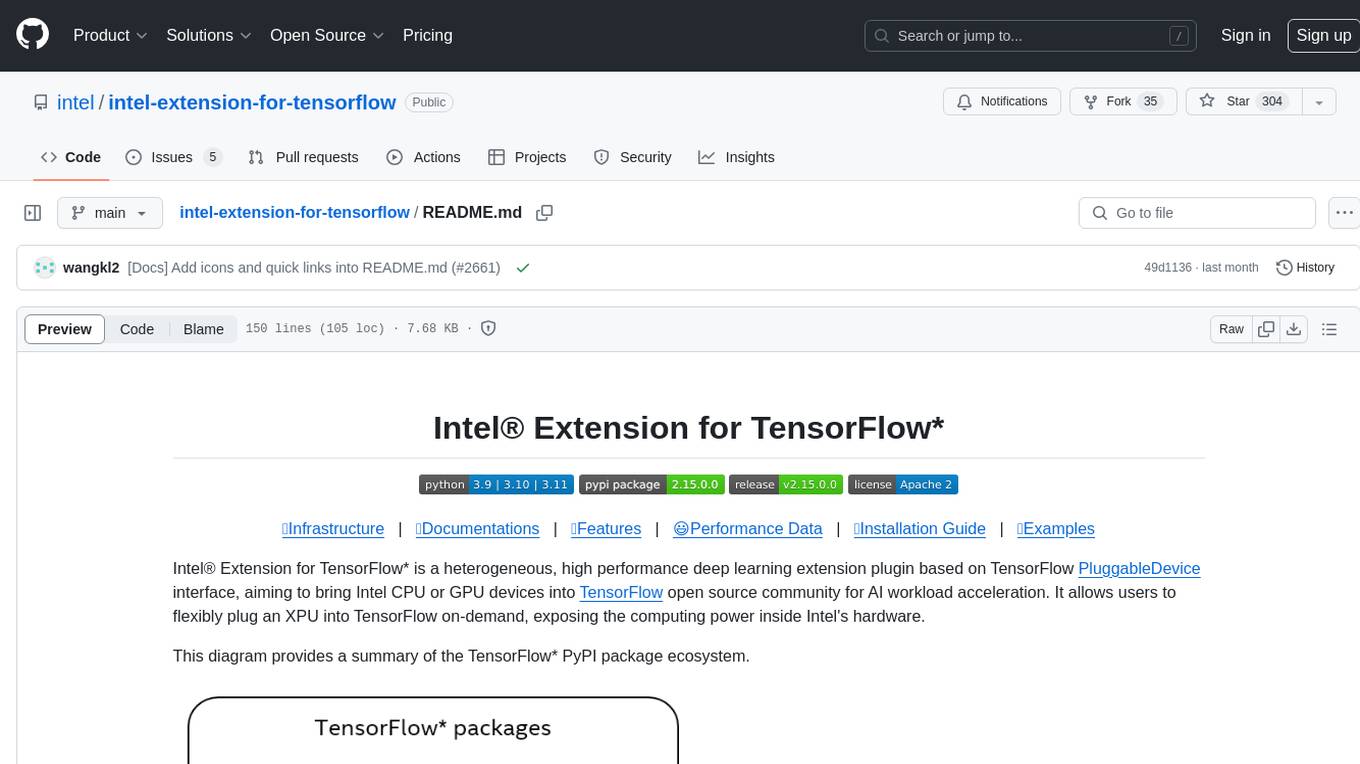
intel-extension-for-tensorflow
Intel® Extension for TensorFlow* is a high performance deep learning extension plugin based on TensorFlow PluggableDevice interface. It aims to accelerate AI workloads by allowing users to plug Intel CPU or GPU devices into TensorFlow on-demand, exposing the computing power inside Intel's hardware. The extension provides XPU specific implementation, kernels & operators, graph optimizer, device runtime, XPU configuration management, XPU backend selection, and options for turning on/off advanced features.
For similar tasks

LLM-Finetune-Guide
This project provides a comprehensive guide to fine-tuning large language models (LLMs) with efficient methods like LoRA and P-tuning V2. It includes detailed instructions, code examples, and performance benchmarks for various LLMs and fine-tuning techniques. The guide also covers data preparation, evaluation, prediction, and running inference on CPU environments. By leveraging this guide, users can effectively fine-tune LLMs for specific tasks and applications.
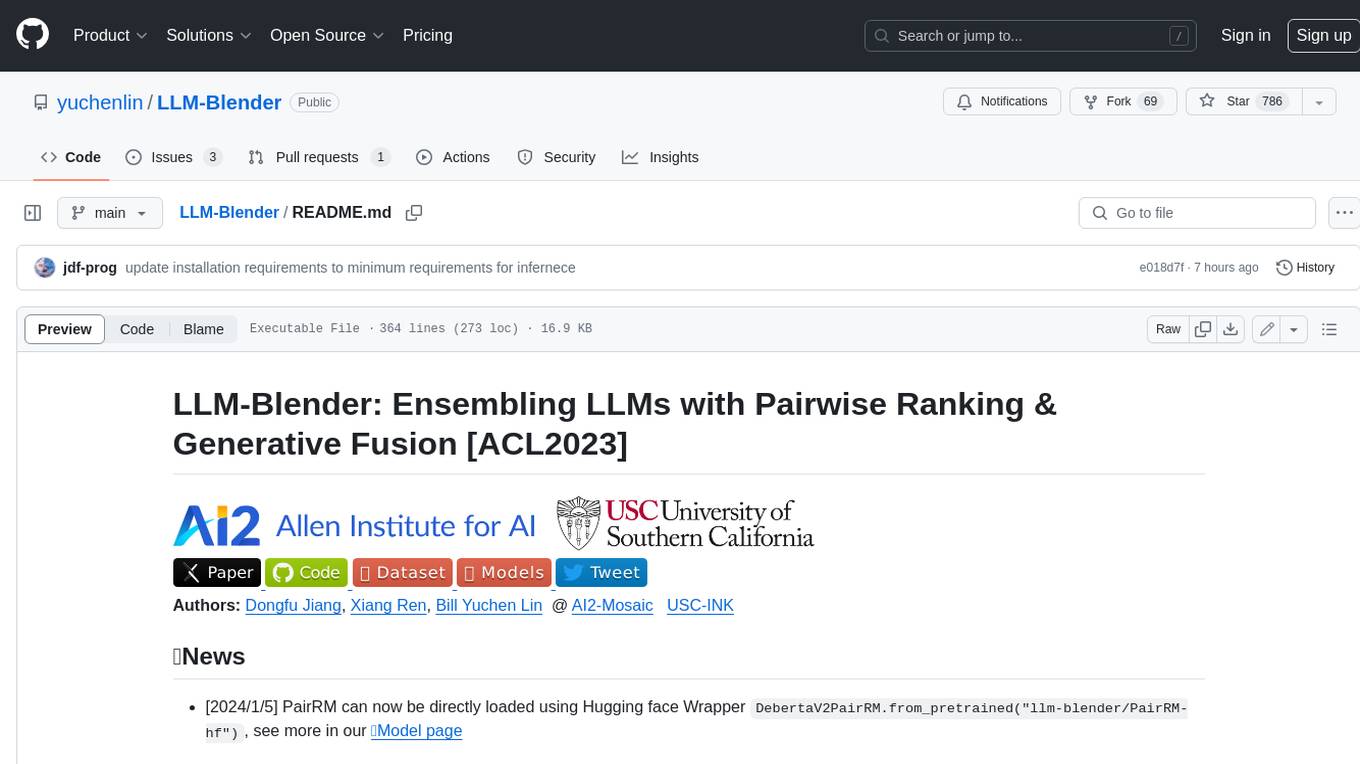
LLM-Blender
LLM-Blender is a framework for ensembling large language models (LLMs) to achieve superior performance. It consists of two modules: PairRanker and GenFuser. PairRanker uses pairwise comparisons to distinguish between candidate outputs, while GenFuser merges the top-ranked candidates to create an improved output. LLM-Blender has been shown to significantly surpass the best LLMs and baseline ensembling methods across various metrics on the MixInstruct benchmark dataset.
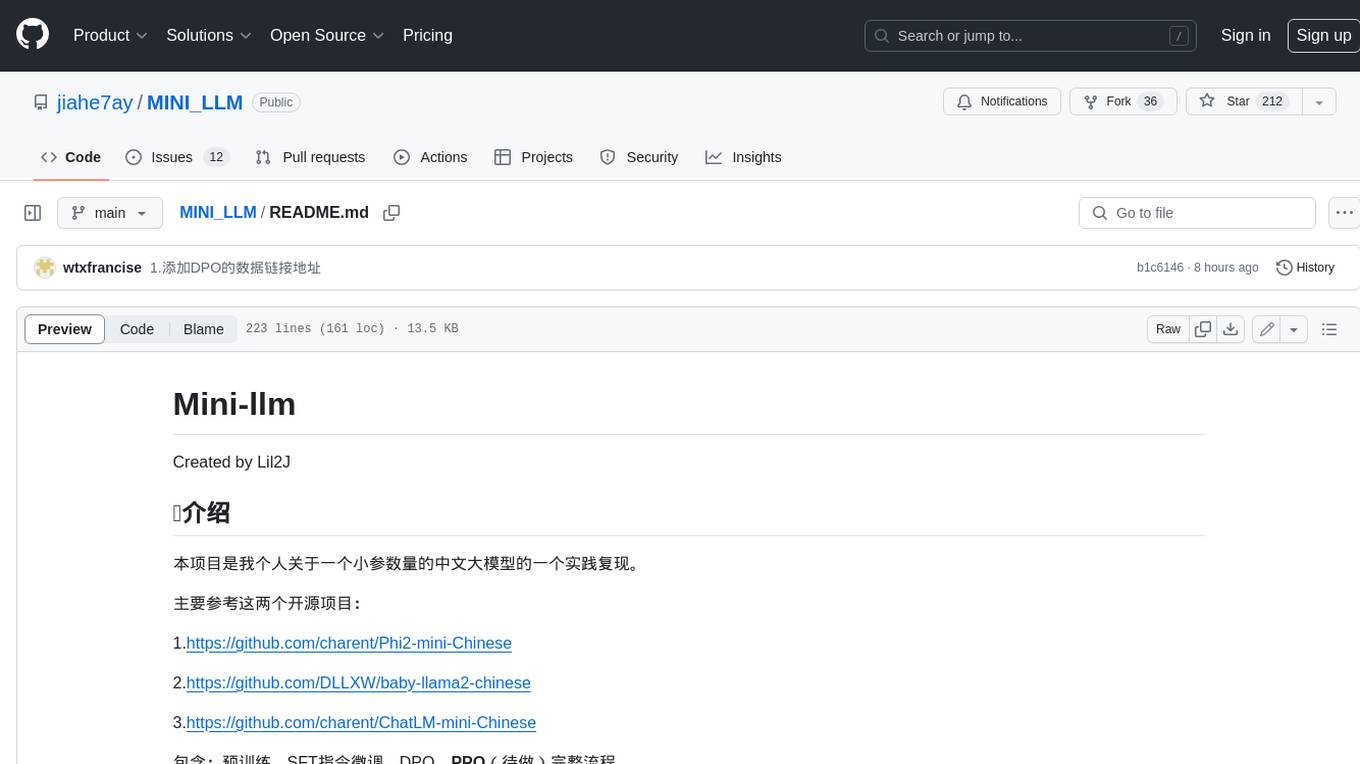
MINI_LLM
This project is a personal implementation and reproduction of a small-parameter Chinese LLM. It mainly refers to these two open source projects: https://github.com/charent/Phi2-mini-Chinese and https://github.com/DLLXW/baby-llama2-chinese. It includes the complete process of pre-training, SFT instruction fine-tuning, DPO, and PPO (to be done). I hope to share it with everyone and hope that everyone can work together to improve it!
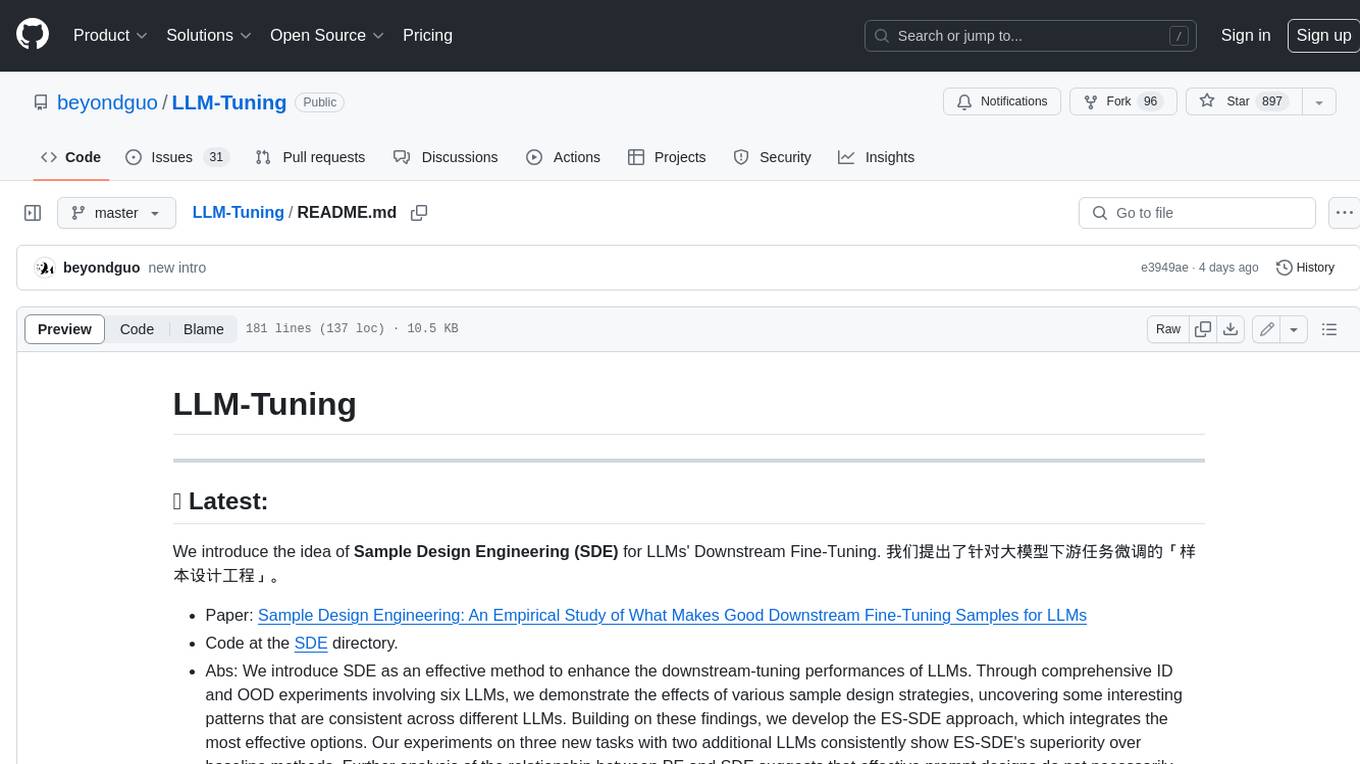
LLM-Tuning
LLM-Tuning is a collection of tools and resources for fine-tuning large language models (LLMs). It includes a library of pre-trained LoRA models, a set of tutorials and examples, and a community forum for discussion and support. LLM-Tuning makes it easy to fine-tune LLMs for a variety of tasks, including text classification, question answering, and dialogue generation. With LLM-Tuning, you can quickly and easily improve the performance of your LLMs on downstream tasks.
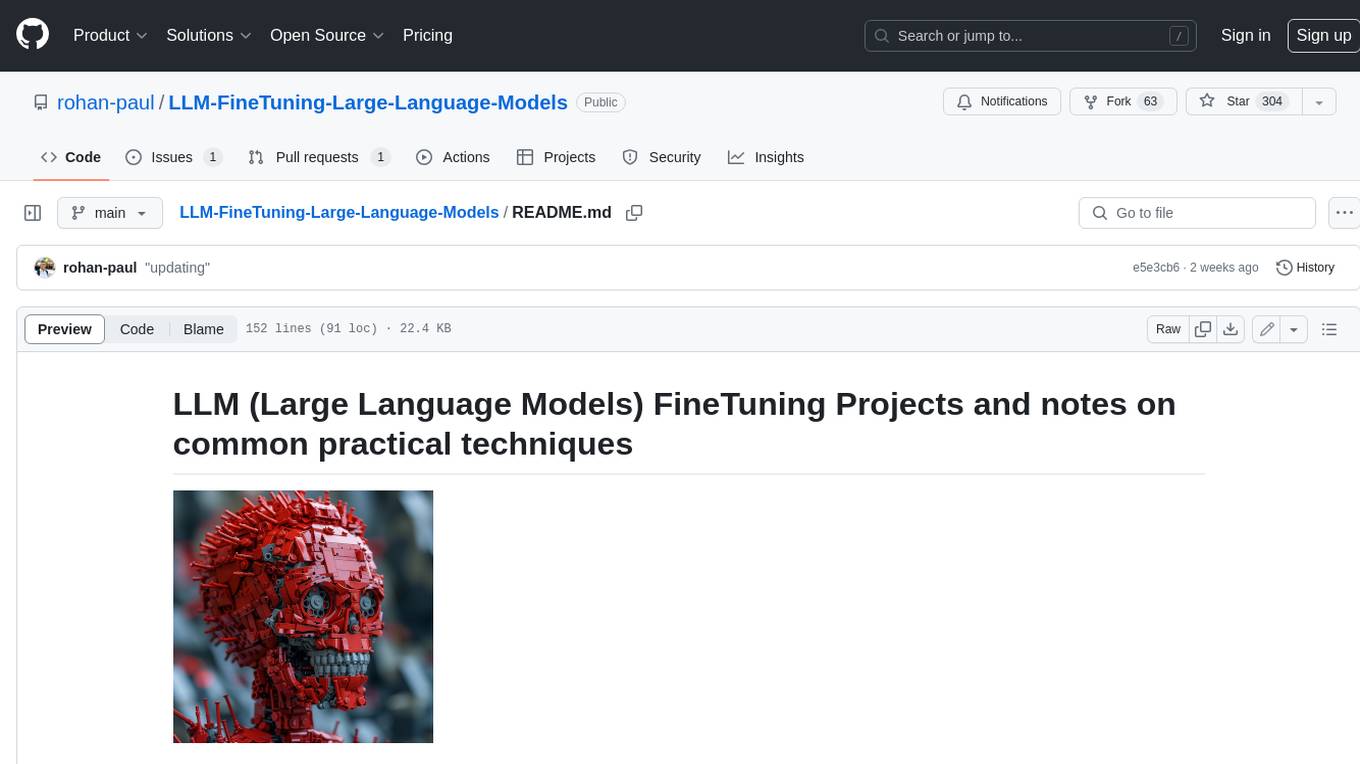
LLM-FineTuning-Large-Language-Models
This repository contains projects and notes on common practical techniques for fine-tuning Large Language Models (LLMs). It includes fine-tuning LLM notebooks, Colab links, LLM techniques and utils, and other smaller language models. The repository also provides links to YouTube videos explaining the concepts and techniques discussed in the notebooks.
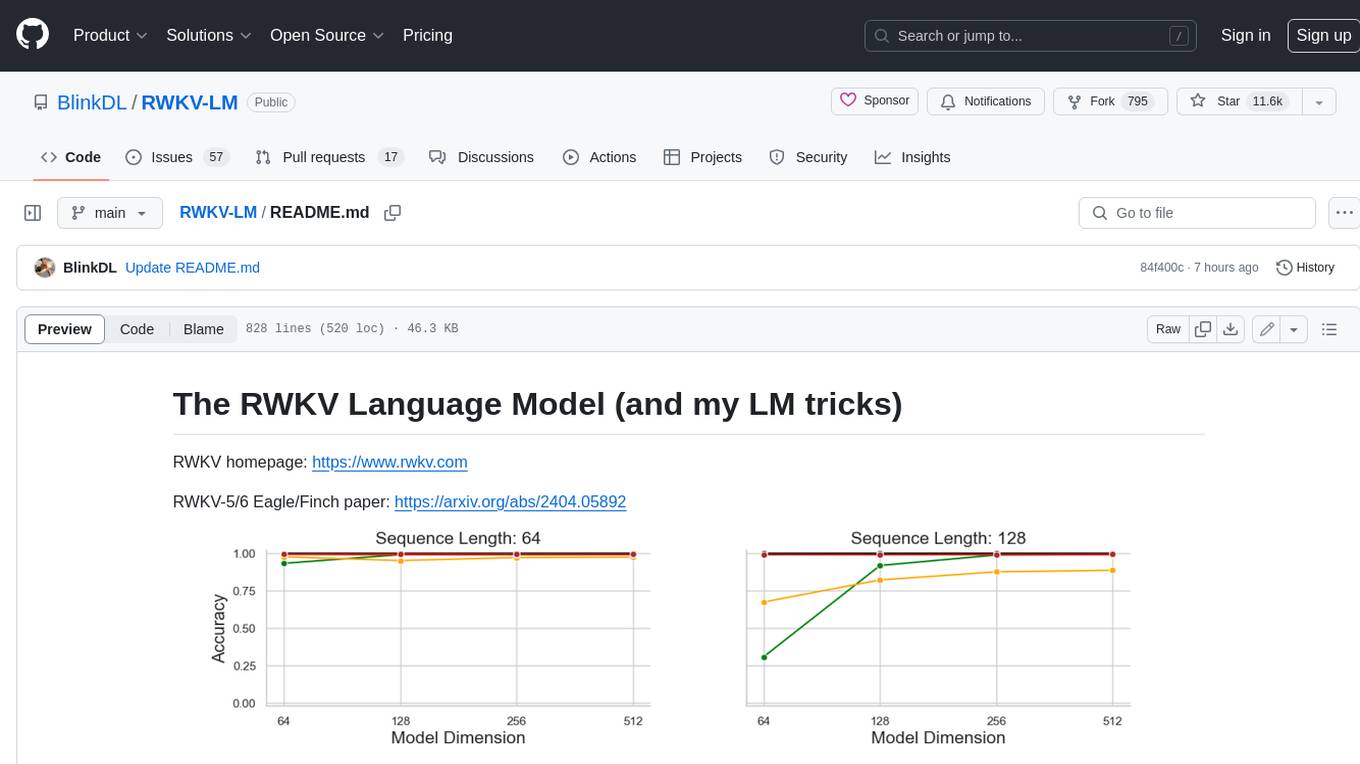
RWKV-LM
RWKV is an RNN with Transformer-level LLM performance, which can also be directly trained like a GPT transformer (parallelizable). And it's 100% attention-free. You only need the hidden state at position t to compute the state at position t+1. You can use the "GPT" mode to quickly compute the hidden state for the "RNN" mode. So it's combining the best of RNN and transformer - **great performance, fast inference, saves VRAM, fast training, "infinite" ctx_len, and free sentence embedding** (using the final hidden state).
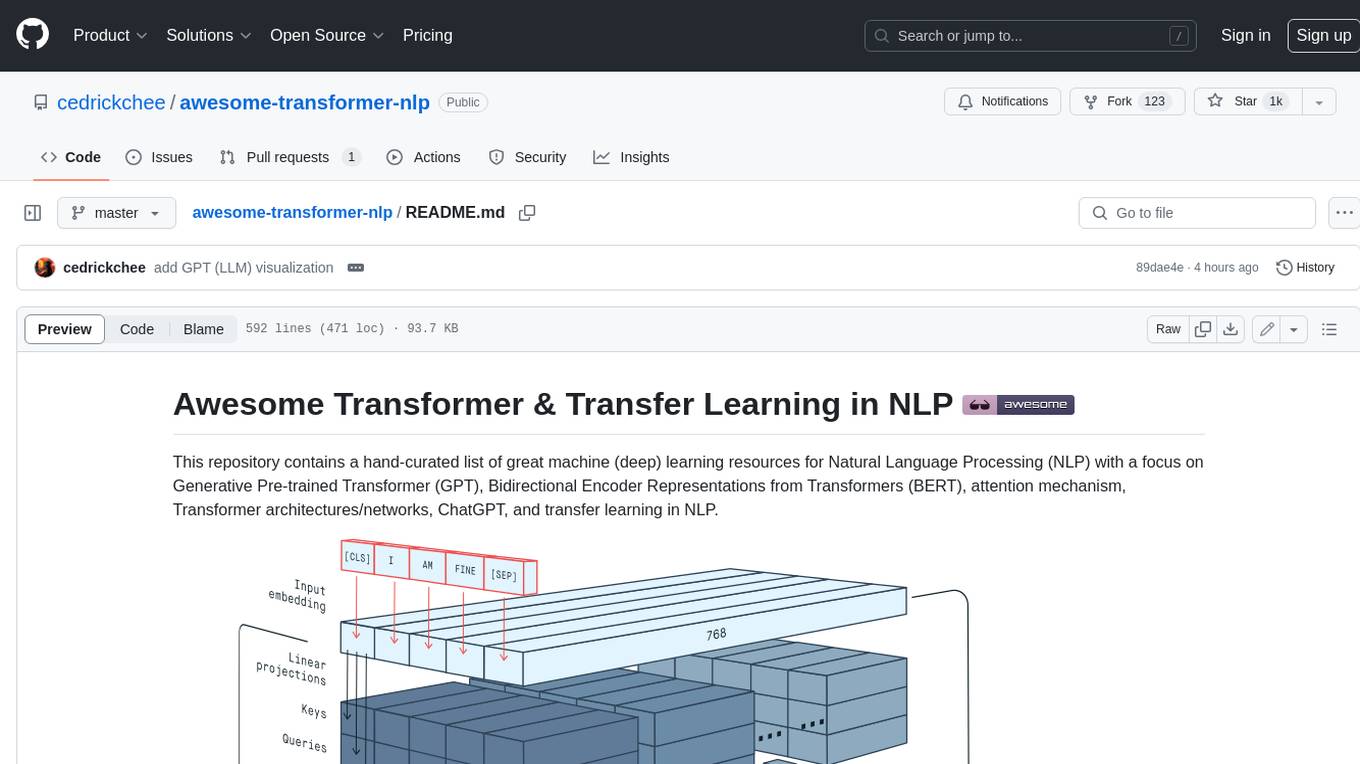
awesome-transformer-nlp
This repository contains a hand-curated list of great machine (deep) learning resources for Natural Language Processing (NLP) with a focus on Generative Pre-trained Transformer (GPT), Bidirectional Encoder Representations from Transformers (BERT), attention mechanism, Transformer architectures/networks, Chatbot, and transfer learning in NLP.
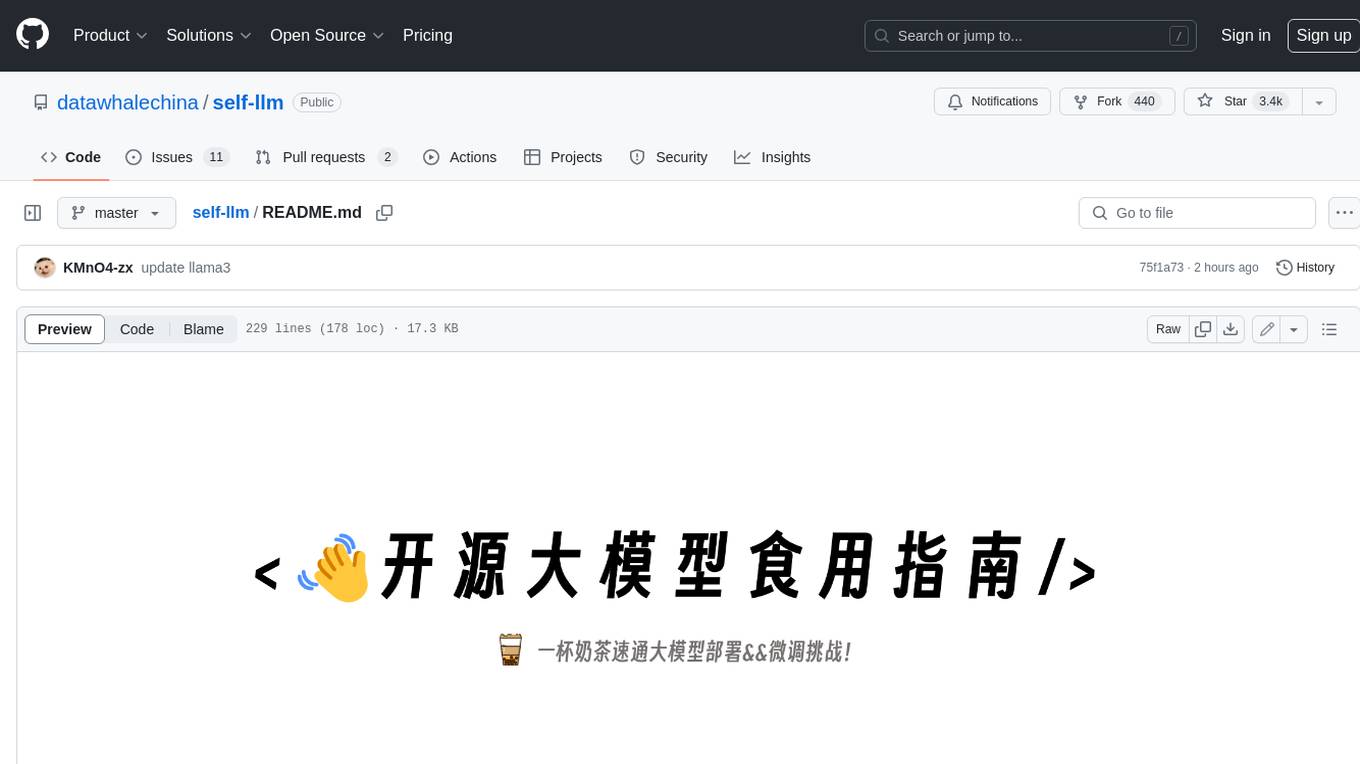
self-llm
This project is a Chinese tutorial for domestic beginners based on the AutoDL platform, providing full-process guidance for various open-source large models, including environment configuration, local deployment, and efficient fine-tuning. It simplifies the deployment, use, and application process of open-source large models, enabling more ordinary students and researchers to better use open-source large models and helping open and free large models integrate into the lives of ordinary learners faster.
For similar jobs

weave
Weave is a toolkit for developing Generative AI applications, built by Weights & Biases. With Weave, you can log and debug language model inputs, outputs, and traces; build rigorous, apples-to-apples evaluations for language model use cases; and organize all the information generated across the LLM workflow, from experimentation to evaluations to production. Weave aims to bring rigor, best-practices, and composability to the inherently experimental process of developing Generative AI software, without introducing cognitive overhead.

LLMStack
LLMStack is a no-code platform for building generative AI agents, workflows, and chatbots. It allows users to connect their own data, internal tools, and GPT-powered models without any coding experience. LLMStack can be deployed to the cloud or on-premise and can be accessed via HTTP API or triggered from Slack or Discord.

VisionCraft
The VisionCraft API is a free API for using over 100 different AI models. From images to sound.

kaito
Kaito is an operator that automates the AI/ML inference model deployment in a Kubernetes cluster. It manages large model files using container images, avoids tuning deployment parameters to fit GPU hardware by providing preset configurations, auto-provisions GPU nodes based on model requirements, and hosts large model images in the public Microsoft Container Registry (MCR) if the license allows. Using Kaito, the workflow of onboarding large AI inference models in Kubernetes is largely simplified.

PyRIT
PyRIT is an open access automation framework designed to empower security professionals and ML engineers to red team foundation models and their applications. It automates AI Red Teaming tasks to allow operators to focus on more complicated and time-consuming tasks and can also identify security harms such as misuse (e.g., malware generation, jailbreaking), and privacy harms (e.g., identity theft). The goal is to allow researchers to have a baseline of how well their model and entire inference pipeline is doing against different harm categories and to be able to compare that baseline to future iterations of their model. This allows them to have empirical data on how well their model is doing today, and detect any degradation of performance based on future improvements.

tabby
Tabby is a self-hosted AI coding assistant, offering an open-source and on-premises alternative to GitHub Copilot. It boasts several key features: * Self-contained, with no need for a DBMS or cloud service. * OpenAPI interface, easy to integrate with existing infrastructure (e.g Cloud IDE). * Supports consumer-grade GPUs.

spear
SPEAR (Simulator for Photorealistic Embodied AI Research) is a powerful tool for training embodied agents. It features 300 unique virtual indoor environments with 2,566 unique rooms and 17,234 unique objects that can be manipulated individually. Each environment is designed by a professional artist and features detailed geometry, photorealistic materials, and a unique floor plan and object layout. SPEAR is implemented as Unreal Engine assets and provides an OpenAI Gym interface for interacting with the environments via Python.

Magick
Magick is a groundbreaking visual AIDE (Artificial Intelligence Development Environment) for no-code data pipelines and multimodal agents. Magick can connect to other services and comes with nodes and templates well-suited for intelligent agents, chatbots, complex reasoning systems and realistic characters.




